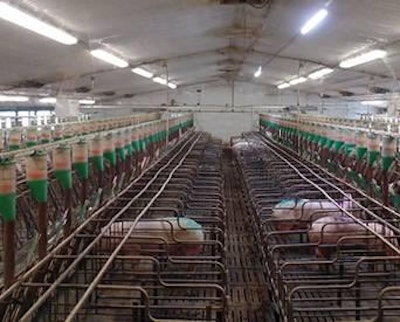
Making the change in sow housing is front and center for U.S. pork producers. And so is the shortage of quality employees willing to work on hog farms. Currently the states that have banned the use of gestation crates require that sows be in pens where they have the ability to turn around — there are no size requirements. But hog producers have their own requirements that they need to meet: labor and profit. The shrinking number of people willing to work on hog farms is forcing producers to rely on technology to manage their farms and feed their pigs. And at the end of the day, pork producers still need to make a profit.
"Producers that have to transition to group sow housing are very concerned that they are going to lose the level of production that they know they need for cash flow,” says Ron Bates, Michigan State University director of agriculture and agribusiness extension. It can cost producers approximately $300 to $400 per sow to make the change to group sow housing. “There are no bonuses for making these changes,” he says. “But there eventually can be penalties, dependent on the state where producers live and their market.”
Housing changes pressured by legislation, consumer demand
In April, an undercover investigator for the Humane Society of the United States (HSUS) released an anonymous video renouncing the HSUS’ motive for banning the use of gestation crates: “When they’re not in crates, they [sows] fight each other. With gestation crates, they can’t bite each other. They’re in a safe spot.”
This leak is a possible game changer against HSUS, who has organized its power in nine ballot initiative states to ban the use of gestation crates. According to the whistleblower, the movement to ban the use of gestation crates has nothing to do with the humane treatment of pigs and everything to do with harming the swine industry.
Nonetheless, every state has its own legislative power, and 41 states have yet to consider the ban. “There are some states that this isn’t even on their radar,” says Bates. But he explains that producers should still consider making the changes to sow housing if they plan to farm in the future. “Producers need to think systematically about making the switch if the ban would occur via legislation in their state or from their meat packer.” Many meat packers have begun encouraging their suppliers to make the switch to “roomier” housing within the next ten years.
Housing requirements that meet future demands
The sow housing movement is not temporary and will eventually affect the entire industry. Stephane Clement, JYGA Technologies (GESTAL) vice president of business development, advises that producers do research on sow housing that will also be sustainable in the long term.
“Automation and monitoring is something that will be essential in the future,” says Clement, adding that right now the growing challenge for pork producers is finding enough quality employees to run their swine operation.
“Having GPS for feed consumption will be essential in the future because we are managing micro profits,” he says. Sixty-five percent of the cost of production is feed consumption, and, according to Clement, it’s a big risk for pork producers to rely on the shortage of quality employees to feed their pigs. “Labor is not always reliable, and the work load is too big to do yourself,” he says.
Clement's other advice is to keep housing updates simple and to not invest in something that you cannot repair yourself. “For biosecurity's sake, if you can’t buy something that you can repair yourself then you need make sure that you can remove the technology from your barns to be worked on,” he says. “It’s better to send technicians to the farm machine shop. Not the barn.”
State by state movement
Because there are different guidelines per state it is unlikely that there will be national regulation on sow housing requirements. “The change is going to happen differently than it happened in other countries,” says Bates. “It’s going to be through patchwork through state legislation and consumer demand.” Whether it’s by individual state legislation or meat packer contracts, the sow housing requirements will become more defined, and the ban on gestation crates will become more prevalent.

















